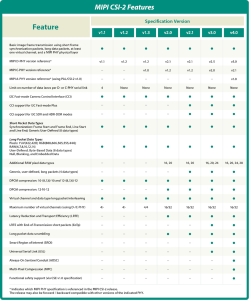The MIPI Alliance has released an update to its MIPI Camera Serial Interface 2 (MIPI CSI-2) interface to enable enhanced machine vision applications. A key feature of the MIPI CSI-2 v4.0 is an advanced always-on imaging solution that operates over as few as two wires to lower cost and complexity for ultra-low-power machine vision applications. These applications range widely from mobile, augmented and virtual reality, and client devices such as tablets, notebooks, and all-in-one computers to drones, the internet of things (IoT) devices, medical devices, industrial systems, and automobiles.

Click the chart for a complete list of CSI-2 features, segmented by specification versions. (Source: MIPI Alliance)
Typically implemented for shorter-reach applications on either a MIPI C-PHY or MIPI D-PHY physical-layer interface, v4.0 is the first to support transmission of CSI-2 image frames over the low-cost, low-pin-count MIPI I3C/I3C Basic two-wire interface, said the MIPI Alliance. CSI-2 can also be implemented over the MIPI A-PHY long-reach SerDes interface (up to 15 m) for use in applications such as as automotive advanced driver-assistance systems (ADAS) and in-vehicle infotainment, and industrial IoT.
CSI-2 v4.0 also adds multi-pixel compression for the latest generation of advanced image sensors and RAW28 color depth to provide higher image quality and signal-to-noise (SNR) ratio.
“With its new features, v4.0 vastly expands the range of application, from simplified, low-power environmental monitoring, to compression and superior image quality for high-performance, safety-critical applications,” said Joel Huloux, chairman of MIPI Alliance, in a statement.
The new features include the following:
- The Always-On Sentinel Conduit (AOSC)enables always-on machine vision systems that use ultra-low-power image sensors and video signal processors (VSPs) to continuously monitor their surrounding environments and then wake their higher-power, host CPUs only when significant events happen, said the organization. It allows image frames to be streamed from an image sensor to a VSP over a low-power MIPI I3C bus more efficiently and with scaling options to add extra I3C lanes and bandwidth as defined by the I3C specification.
- Multi-pixel compression(MPC) provides optimized pixel compression for the latest generation of Tetra- and Nonacell image sensors with multi-pixel color filter arrays (CFAs). This helps alleviate the high bandwidth demands of these sensors by compressing both multi-pixel and standard Bayer CFA images more efficiently and with potentially higher quality than current methods, said the organization. Reference code is available to help integrators evaluate the algorithm and verify their implementations.
- RAW28pixel encoding supports the next generation of high-dynamic-range automotive image sensors for applications such as those required for ADAS and other safety-critical systems.
CSI-2 v4.0 is backward compatible with all previous versions of the MIPI specification. More information can be found in the “MIPI CSI-2 v4.0 Panel Discussion with the MIPI Camera Working Group” presentation.
MIPI CSI-2, introduced in 2005, has become a widely used embedded camera and imaging interface. As the de facto high-speed protocol for the transmission of still and video images from image sensors to application processors, it supports a broad range of use cases, said the organization.
Advertisement







